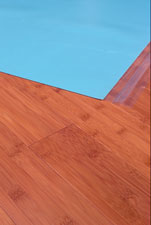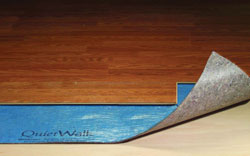The plethora of green building materials is impacting product choices in the residential and commercial markets, and underlayments are no exception. By  lowering the environmental footprint, vendors claim they are helping reduce global warming emissions, consuming less non-renewable energy and preserving natural resources.
lowering the environmental footprint, vendors claim they are helping reduce global warming emissions, consuming less non-renewable energy and preserving natural resources.
“Today’s consumer is more educated than ever before, and she will continue to further her education in the future,” noted Drew Holland, marketing manager, Healthier Choice, a producer of carpet cushion and acoustic solutions. “She is looking for products that are not only good for the environment, but also healthy for her home and family.”
Increased consumer education is cited by experts as one of the biggest reasons why environmentally friendly underlayments are rapidly gaining acceptance in the marketplace. Consumers are reportedly becoming more aware of the movement toward greener building products through marketing by manufacturers and retailers. The end result is the rapid development of underlayments featuring higher concentrations of sustainable and renewable resources in their construction.
Recycled content
A case in point is MP Global Products, which utilizes approximately 760 tons of recycled textile and carpet fibers each month that normally would have gone into landfills, according to Jack Boesch, director of marketing. MP Global, founded 13 years ago to specifically manufacture flooring underlayments made from recycled materials, claims its fiber underlayments carry some of the highest official recognitions ever handed out by Scientific Certification System (SCS). “Our best products are certified to contain from 95% to 100% recycled materials and have been awarded their prestigious Indoor Advantage Gold seal as a contributor to clean indoor air quality,” he said. “This basically clears the way for use in hospitals, schools and government building projects.”
Finding building products that contribute to valuable LEED credits is providing further incentive for suppliers to invest in R&D. “The most important factor for us is the trend toward LEED-certified construction,” said Phil Pitts, Bostik’s hardwood installation products market manager. “We manufacture only low or zero VOC products to minimize air pollution and improve indoor air quality. We avoid technologies that out-gas high amounts of toxic substances, such as methanol.”
Renewable sourcing
Bio materials, such as polyols derived from soybean oil and other food sources, have reportedly reached a point in product development that allows them to be included in ever-increasing amounts, displacing equal parts of petroleum-derived components. “The use of bio materials lessens our dependence on  petrochemicals and reduces global warming emissions while supporting local farmers and producers,” Holland said. Healthier Choice designed a bio-based manufacturing process using renewable resources which not only lessens its dependence on foreign oil but enhances the sustainability of its products.
petrochemicals and reduces global warming emissions while supporting local farmers and producers,” Holland said. Healthier Choice designed a bio-based manufacturing process using renewable resources which not only lessens its dependence on foreign oil but enhances the sustainability of its products.
Foam Products uses BIOH, a rapidly renewable soybean polyol, and vegetable oils in a foam compound to produce its Eco-Silencer HD/Ultimate underlayment line. “This lessens our dependence on petroleum-based oils,” said Jim Wink, national sales and business development. In addition to emitting lower VOC emissions, vendors claim the latest underlayments offer improved antimicrobial protection. “All of our underlayments include Ultra-Fresh antimicrobial, which prevents growth of odor-causing mold, mildew and bacteria for a healthy, odor-free, hypoallergenic surrounding,” said Healthier Choice’s Holland. “So they’re good for the environment, inside and out.” The company claims to offer the only Greenguard Indoor Air Quality Certified underlayments.
Maintaining performance attributes
While not all products are created the same, most suppliers guarantee floors won’t warp, delaminate, buckle, ridge or telegraph seams because of underlayment failure. Some claim the latest green underlayments outperform many petroleum- and chemical-based products in several key areas, such as noise reduction. “We’ve spent thousands [of dollars] on independent testing for our products in order to prove our performance,” Boesch said. “Increasingly more architects and designers specify our products for multi-family housing, such as condominiums and apartment buildings, because of their ability to deaden noise between floors.” MP’s most popular product is QuietWalk underlayment for floating wood and laminate floors—which smoothes out small subfloor imperfections and reduces sound transmission—while a new line called FiberBacker targets crack isolation and noise abatement for tile floors.
Bostik’s newest hardwood adhesive, Ultra Set Single Step, functions as an acoustical and moisture-reducing underlayment. It features post-consumer recycled rubber which acts as a built-in spacer and sound deadening ingredient. “This product outperforms double-stick, multi-step systems involving plastic foams or epoxy coatings,” Pitts said. “In addition to saving on labor and waste, Ultra Set Single Step contains zero VOCs as calculated by SCAQMD 1168, so it contributes to indoor air quality.”
Looking ahead, vendors declare further investments in R&D will yield underlayments whose performance is equal to or better than conventional products and are safer for the environment. For example, Bostik offers cementitious self-leveling cement underlayments which utilize fly ash to improve performance and working characteristics. “Fly ash is a byproduct of burning coal,” Pitts explained, “so every ton used in our cement underlayment is a ton that doesn’t need to be land- filled or otherwise disposed of.”
